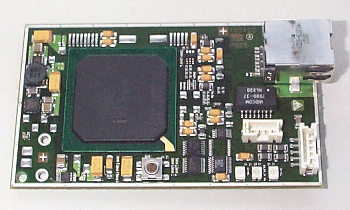World’s smallest security appliance?
Feb 14, 2003 — by LinuxDevices Staff — from the LinuxDevices Archive — 2 viewsInnominate Security Technologies (Berlin, Germany) will unveil what it calls the “world's smallest security appliance” at the Intel Developer Forum in San Jose, CA next week. Measuring just 0.8 x 2.4 x 4 inches, the tiny Firewall/VPN module is based on an Intel IXP425 network processor running an embedded Linux operating system, and offers features previously only available on much larger and more… expensive devices, company sources said.

mGuard performs both firewall and VPN (Virtual Private Network) functions, and provides hardware-based encryption and optional anti-virus scanning. Innominate says the device also implements security functions that prevent the screening and manipulation of data and applications. Additionally, a patent-pending “transparent mode” is said to allow the mGuard to protect computers and embedded systems completely automatically, without needing the configuration or administration procedures typically required by such devices.
Innominate says the mGuard's small size and autonomous operation make it useful for a broad range of embedded system applications, including medical appliances, point-of-sales devices, industrial controllers, and ticket vending machines.
mGuard's embedded computer is based on an Intel IXP425 XScale processor equipped with a choice of 32 or 64 MB RAM memory. A 16 MB Flash “disk” is used to boot the system's embedded operating system and store nonvolatile configuration data. The device is also equipped with two 10/100 Mbits/sec Ethernet ports, a USB interface, and a hardware-based 3DES encryption chip.
Linux inside
Innominate created a customized embedded Linux operating system implementation for the mGuard, derived from Debian Linux 2.4, explained Innominate chief operating officer Olaf Siemens. Using Linux made it possible for the device's functions to be flexibly modified and extended for application-specific requirements, Siemens said.
The company had decided to work with a very early version of a completely new Intel networking chip, with the result that the development team had to create some missing drivers in order to meet the project's release schedule. “It was also necessary to build our own tool chain [and package management] in order to make mGuard fly,” added Siemens.
“We are very glad to have chosen Linux,” said Siemens. “From our perspective, Linux is the perfect choice for embedded systems. Given our long experience in embedded Linux with previous products we have been able to pull off a very complex development in a very short time. It's the way to go!”
This article was originally published on LinuxDevices.com and has been donated to the open source community by QuinStreet Inc. Please visit LinuxToday.com for up-to-date news and articles about Linux and open source.